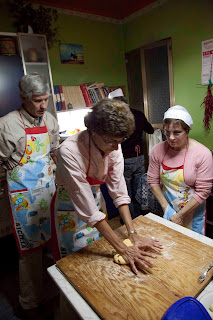1. Though geographically small when viewed in context to the globe, it is the largest region of Italy, nearly 10,000 sq. mi. and has a population of just over 5 million. Sicily is also the largest island in the Mediterranean Sea. Its highest point is Mt. Etna, the largest active volcano in Europe.
2. Major economy today is based on agriculture (olive oil, wine, citrus fruits) and tourism. Agriculture is based on the fertile soil from volcanic eruptions and great weather (except when you want to climb Stromboli). When Sicily was a Roman colony, it was known as the Roman Empire’s granary because of its high output of wheat production. Most important wines are Marsala from the area around the town of Marsala in the west, and Nero d’Avola, a great red wine from Avola near Syracuse in the East.
3. The 1st known inhabitants were the Sicani perhaps coming from the Iberian Peninsula (Spain). There is fossil evidence from 8000 B.C.E.
4. Because of its strategic position between the Middle East, Greece, and the west, Sicily has been colonized and ruled by multiple civilizations including the Phoenicians, Greeks, Carthaginians, Romans, Vandals, Goths, Byzantines, Arabs, Normans, Holy Roman Empire, Austria, and finally Italy with Italian unification under Garibaldi in 1860.
5. Best to know some ancient history before you go. Ruins are everywhere.
6. Though there are excellent limited access highways in many areas linking major cities, driving in the countryside can be challenginging due to steep windy roads and crazy drivers. Parking in both large cities and small hill towns can be next to impossible.
7. Sicily is not very handicap accessible, so if you can’t walk a lot, and climb stairs (especially I hotels with no elevator), I would consider passing on this as a destination.
8. If you travel to Sicily, be prepared to EAT (mange!). Gelato and granita (“Italian ices”)is everywhere and eaten any time. A common on the run breakfast is brioche con gelato a gelato stuffed brioche). The pasta is amazing, best with simple preparation- olive oil, garlic, basil alone, or with mushrooms, eggplant, zucchini, clams, or shrimp. It will be hard to go back to boxed pasta after eating freshly made. Pizza can be really good or really bad. Be careful of your choice in establishments. Quick, fast food pizza from a pasticceria is kind of like frozen pizza at home reheated. The freshly made pizza’s we had were for the most part pretty good.
9. Remember to ask for the check (il conto, per favore). Otherwise you will sit all night at the restaurant. Check to see if there is a service charge added. Many restaurants will add this as well as a per person cover charge to pay for the napkins, silverware and plates (3+euros). Tipping is not mandatory and you should not tip more than 10%.
10. The people, especially in the small towns were very friendly, and were patient with my attempts at speaking Italian. Many people speak some English, but don’t count on this in the smaller villages. Since Italians use there hands a lot to speak, they are pretty good a charades, so you can usually get your point across.




























































